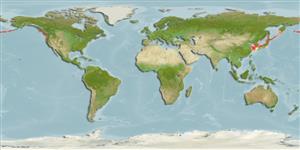Common names from other countries
分类 / Names
俗名 | 同种异名 | Catalog of Fishes(属, 种) | ITIS | CoL | WoRMS | Cloffa
Environment: milieu / climate zone / depth range / distribution range
生态学
海洋 居于水底的; 海洋洄游的 (Ref. 51243); 深度上下限 0 - 172 m (Ref. 114018). 溫帶; 54°N - 30°N, 118°E - 118°W
Northwest Pacific: inland Sea of Japan to Kyushu, Japan. Northeast Pacific: From southern California to the western Aleutian Islands (Ref. 114018), Alaska (Ref. 11366).
西北太平洋: 日本到日本北海道的內海。 東北太平洋: 阿拉斯加州.(參考文獻 11366)
大小 / 重量 / 年龄
Maturity: Lm ? range ? - ? cm
Max length : 15.0 cm SL 雄鱼/尚未辨别雌雄; (Ref. 559); common length : 10.0 cm SL 雄鱼/尚未辨别雌雄; (Ref. 559); 最大体重: 10.60 g (Ref. 112063); 最大年龄: 3.00 年 (Ref. 125612)
背棘 (总数) : 0; 背的软条 (总数) : 55 - 59; 臀棘: 0; 臀鳍软条: 28 - 32; 脊椎骨: 62 - 67. Characterized by having a horizontal skin fold along its ventral contour, and the absence of pelvic fin and teeth. Lateral plicae 160 to 180. Lower jaw pointed. Lateral line system on head not continuous with that on the body.
特徵为有一个水平的皮肤摺层沿着它的腹轮廓, 与那缺乏腹鳍与齿。 侧面的皱摺 160 到 180. 下颌尖的。 在头部上的侧线系统在身体上不与那续接在一起。
Found in sand bottoms and may enter semi-enclosed sea areas (Ref. 11230). Forms large schools. Important food fish in Japan (marketed fresh or dried) and marketed fresh but mainly used for meal and oil manufacture in Europe (Ref. 10384). Common size taken from picture in Ref. 559. Maximum size estimated as 1.5 * common size. Two genetically different lineages were found in Japan Sea/East Sea, perhaps representing two different species (J.K. Kim, oral.comm, FishBoL2012, June 2012).
发现于砂质底部了而且可能进入半封闭的海洋区域.(参考文献 11230) 形成大群鱼群。 在日本 (在市场上销售生鲜地或者乾燥的) 的重要食用鱼而且在市场上销售生鲜地但是主要地在欧洲用来了食物与油脂产品.(参考文献 10384) 普遍的大小参考文献 559 取自了照片。 最大体长估计如 1.5* 普遍大小。
Life cycle and mating behavior
Maturities | 繁殖 | Spawnings | Egg(s) | Fecundities | 仔鱼
西北太平洋: 日本到日本北海道的內海。 東北太平洋: 阿拉斯加州.(參考文獻 11366)
Masuda, H., K. Amaoka, C. Araga, T. Uyeno and T. Yoshino, 1984. The fishes of the Japanese Archipelago. Vol. 1. Tokai University Press, Tokyo, Japan. 437 p. (text). (Ref. 559)
CITES (Ref. 128078)
Not Evaluated
人类利用
渔业: 高经济性
工具
特别资料
下载 XML
网络资源
Estimates based on models
Preferred temperature (Ref.
115969): 11.9 - 23, mean 19.1 (based on 74 cells).
Phylogenetic diversity index (Ref.
82804): PD
50 = 0.5156 [Uniqueness, from 0.5 = low to 2.0 = high].
Bayesian length-weight: a=0.01000 (0.00524 - 0.01907), b=3.23 (3.06 - 3.40), in cm Total Length, based on LWR estimates for this species & Genus-body shape (Ref.
93245).
营养阶层 (Ref.
69278): 3.1 ±0.1 se; based on size and trophs of closest relatives
回复力 (Ref.
120179): 高度, 族群倍增时间少于 15个月 (K=0.6).
Prior r = 0.79, 95% CL = 0.52 - 1.18, Based on 4 data-limited stock assessments.
Fishing Vulnerability (Ref.
59153): Low vulnerability (14 of 100).
Climate Vulnerability (Ref.
125649): Low vulnerability (17 of 100).
